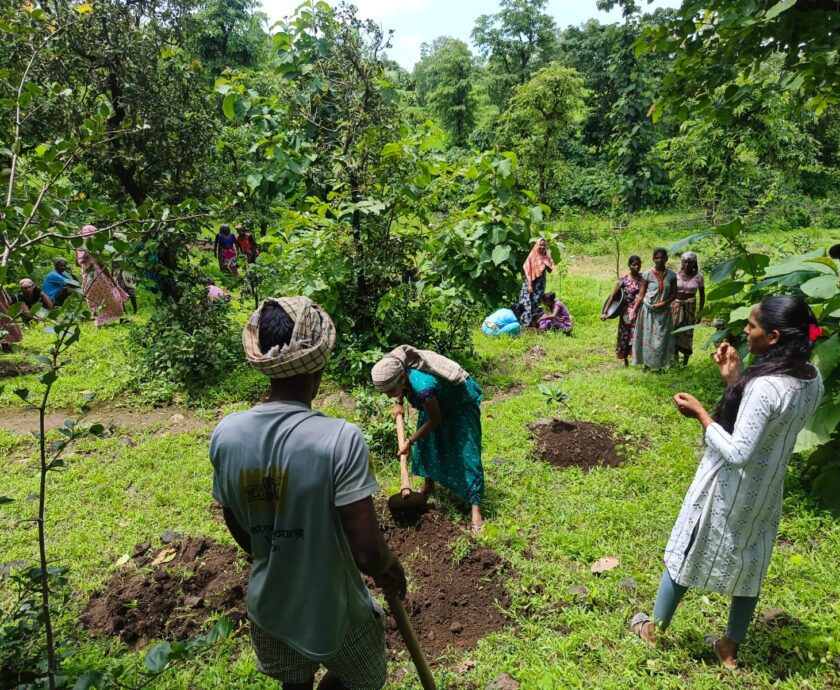Background:
Subsidized horticulture was an ambitious programme in the State of Maharashtra under the Employment Guarantee scheme of the Government in the year 1990-91. The concept of orchard cultivation or horticulture was embedded in the minds of farmers thereon. This has been a boon to the barren land in the state, which sees an overall orchard cultivation in more than 18 lakh hectares of land in various places. But the fact lies that orchard cultivation has not met the farmer’s expectations of increase in their earning potential. This is basically due to improper and inadequate information, apathy among farmers,water scarcity during non-monsoon months, type of land and climate and lack of processing units to store excess production when the market is low.
Mokhada, a tribal block in Palghar district receives adequate rainfall , but storage of water is difficult due to the steep slopes and rocks, which led to rainfed agriculture and seasonal migration for employment in the non-monsoon months. The land remains barren for most of the year and the plantation of orchards was a distant dream even with government and other social institutions putting in great efforts to restore the soil. Adaptation to new technology was also slow considering the marginal status of the farmers in tribal communities.
In this context, to make the community understand the importance of agriculture and its commercialisation, AROEHAN in the year 2011 started working on development of good agricultural practices in the taluka. From plantation of vegetables, floriculture and then horticulture, AROEHAN developed a group of farmers and helped them realize that agriculture can be a sustainable source of livelihood. But still the challenges of transportation of produce and water scarity were huge. Water conservation structures like check dams, dams, cordons, sub surface bunds along with solar pumps were constructed. This helped the farmers whose lands were in the plains or slopes. But the farmland on hill tops and far to reach areas from water sources were still left out. Orchards need uninterrupted irrigation in the first three years of their growth. Inorder to bring in more land under cultivation, the idea of a farm pond or jalkund was initiated.
Jalkund (Farm ponds) and horticulture:
To help farmers having farms on hill tops and hill slopes with water scarcity generate a stable source of income for their families, it was decided to plant 70 fruit trees in half an acre of land with 5m x 5m distancing among the saplings. In addition to the plantation, a farm pond or jalkund with dimensions 6m x 5m x 1m was also constructed, keeping in mind that water storage for 8 months post monsoon i.e 30000 liters (25000 litres @ 10 litres per plant for 8 months and evaporation quotient) should be made available. Thorny plants like sagargota were planted as a fence to avoid free cattle. 250 farmers have been included in this plantation drive.
| Area | Fruit trees | Number of saplings |
|---|---|---|
| 20 gunthas | Mangoes | 10 |
| Cashew | 15 | |
| Lemon | 5 | |
| Black Jamun | 5 | |
| Guava | 5 | |
| Gooseberry | 5 | |
| Teak | 5 | |
| Papaya | 5 | |
| Drumstick | 5 | |
| Bamboo | 10 | |
| Total | 70 |
The farm pond is a boon to the farmers in this area , where in the previous years the survival rate of the plants was only 50% owing to water scarcity post October, this year the survival rate has increased to 75%. Watering the plants during traditional farming was found to be difficult due to the distance from the water source and the time taken. Now that the jalkund is in the vicinity , it becomes easier for the farmers to water the plants twice daily leading to better growth and survival.
Survey of plants in March:
| Item | Mangoes | Cashew | Lemon | Black Jamun | Guava | Goose berry | Teak | Papaya | Drumstick | Bamboo | Total |
|---|---|---|---|---|---|---|---|---|---|---|---|
| Number of saplings | 2000 | 3000 | 1000 | 1000 | 1000 | 1000 | 1000 | 1000 | 1000 | 2000 | 14000 |
| Living saplings | 1740 | 1960 | 850 | 845 | 886 | 840 | 830 | 310 | 300 | 1800 | 10361 |
Survey of farmpond:
| Normal Storage capacity in litres | Storage in the months of Feb- March | Number of Farm ponds |
|---|---|---|
| 30000 | 10000 | 35 |
| 10000-14000 | 65 | |
| 15000-20000 | 60 | |
| 20000-25000 | 90 |
In the coming months, April and May there is a requirement of 10000 litres of water for irrigation and plant survival. With proper planning and management of water resources the farmers have been able to exceed their water requirement!





